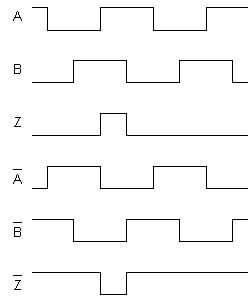

- Changchun Rongde Optics
- Co.,Ltd.
- Add:No.1666 Yaan Road,
- North Lake Development District,
- Changchun 130102,China
- Tel:86-431-81881745
- Fax:86-0431-85256892
- E-mail:rongdecui@roundss.net
- Skype:adacui_roundss
Company News
Current position :Home > News > Photoelectric Sense
Incremental outputs!
Changchun Rongde Optics Co.,Ltd. Release time:2016/3/16 Browse:902There are three signals for incremental output: A, B and Z. Signals A and B are quadrature signals, shifted by 90° and signal Z is a reference mark. One revolution generates N pulses of signal A or B. The number of counts per revolution post quadrature evaluation is N x 4. The reference mark signal is produced once per revolution. The width of the Z pulse is ¼ of quadrature signal period and is matched with A high and B high.
The figure shows the timing diagram of A, B and Z signals with clockwise (CW) rotation of the magnet. B leads A for CW rotation. The counting direction can be changed by swapping A and B signals.
 |
 |
| Timing diagram for incremental output | Differential incremental outputs |
|
|
|
|
CW rotation of magnet - top view (relevant for all IC's and RM/RE encoders) | |
With incremental outputs it is important to know the difference between PPR (pulses per revolution) and CPR (counts per revolution = 4 x PPR)
Pulses per revolution is the number of pulses in one revolution.
Counts per revolution is the number of changes of state on both channels in one revolution. CPR is achieved by electronically multiplying by four, using both the rising and the falling edges on both channels.
 |
| 1 Pulse = 4 Counts |
 Previous:What is the feature of the Gray code?
Previous:What is the feature of the Gray code? Next: What is the position (time) delay of incremental encoder signals?
Next: What is the position (time) delay of incremental encoder signals?




















 Products
Products